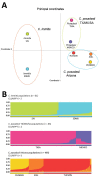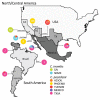Use of Population Genetics to Assess the Ecology, Evolution, and Population Structure of Coccidioides
- PMID: 27191589
- PMCID: PMC4880095
- DOI: 10.3201/eid2206.151565
Use of Population Genetics to Assess the Ecology, Evolution, and Population Structure of Coccidioides
Abstract
During the past 20 years, a general picture of the genetic diversity and population structure of Coccidioides, the causal agent of coccidioidomycosis (Valley fever), has emerged. The genus consists of 2 genetically diverse species, C. immitis and C. posadasii, each of which contains 1 or more distinct populations with limited gene flow. Genotypic data indicate that C. immitis is divided into 2 subpopulations (central and southern California populations) and C. posadasii is divided into 3 subpopulations (Arizona, Mexico, and Texas/South America populations). However, admixture within and among these populations and the current paucity of environmental isolates limit our understanding of the population genetics of Coccidioides. We assessed population structure of Coccidioides in Arizona by analyzing 495 clinical and environmental isolates. Our findings confirm the population structure as previously described and indicate a finer scale population structure in Arizona. Environmental isolates appear to have higher genetic diversity than isolates from human patients.
Keywords: Arizona; Coccidioides immitis; Coccidioides posadasii; United States; Valley fever; coccidioidomycosis; fungi; fungus; microsatellites; population genetics; population structure.
Figures



Similar articles
-
Local Population Structure and Patterns of Western Hemisphere Dispersal for Coccidioides spp., the Fungal Cause of Valley Fever.mBio. 2016 Apr 26;7(2):e00550-16. doi: 10.1128/mBio.00550-16. mBio. 2016. PMID: 27118594 Free PMC article.
-
Population Structure and Genetic Diversity among Isolates of Coccidioides posadasii in Venezuela and Surrounding Regions.mBio. 2019 Nov 26;10(6):e01976-19. doi: 10.1128/mBio.01976-19. mBio. 2019. PMID: 31772050 Free PMC article.
-
The population biology of coccidioides: epidemiologic implications for disease outbreaks.Ann N Y Acad Sci. 2007 Sep;1111:147-63. doi: 10.1196/annals.1406.040. Epub 2007 Mar 7. Ann N Y Acad Sci. 2007. PMID: 17344537 Review.
-
Genetic analysis of the endemic fungal pathogens Coccidioides posadasii and Coccidioides immitis in Mexico.Med Mycol. 2014 Feb;52(2):156-66. doi: 10.1093/mmy/myt005. Epub 2014 Feb 13. Med Mycol. 2014. PMID: 24577001
-
The mysterious desert dwellers: Coccidioides immitis and Coccidioides posadasii, causative fungal agents of coccidioidomycosis.Virulence. 2019 Dec;10(1):222-233. doi: 10.1080/21505594.2019.1589363. Virulence. 2019. PMID: 30898028 Free PMC article. Review.
Cited by
-
Early Events in Coccidioidomycosis.Clin Microbiol Rev. 2019 Oct 16;33(1):e00112-19. doi: 10.1128/CMR.00112-19. Print 2019 Dec 18. Clin Microbiol Rev. 2019. PMID: 31619396 Free PMC article. Review.
-
A microbial risk assessor's guide to Valley Fever (Coccidioides spp.): Case study and review of risk factors.Sci Total Environ. 2024 Mar 20;917:170141. doi: 10.1016/j.scitotenv.2024.170141. Epub 2024 Jan 17. Sci Total Environ. 2024. PMID: 38242485 Free PMC article. Review.
-
Life Cycle Dominates the Volatilome Character of Dimorphic Fungus Coccidioides spp.mSphere. 2021 Apr 14;6(2):e00040-21. doi: 10.1128/mSphere.00040-21. mSphere. 2021. PMID: 33853870 Free PMC article.
-
Utility of Whole-Genome Sequencing to Ascertain Locally Acquired Cases of Coccidioidomycosis, Washington, USA.Emerg Infect Dis. 2019 Mar;25(3):501-506. doi: 10.3201/eid2503.181155. Emerg Infect Dis. 2019. PMID: 30789132 Free PMC article.
-
From soil to clinic: current advances in understanding Coccidioides and coccidioidomycosis.Microbiol Mol Biol Rev. 2024 Dec 18;88(4):e0016123. doi: 10.1128/mmbr.00161-23. Epub 2024 Oct 4. Microbiol Mol Biol Rev. 2024. PMID: 39365073 Review.
References
MeSH terms
Substances
LinkOut - more resources
Full Text Sources
Other Literature Sources
Medical
Miscellaneous

